| DESCRIPTION | HISTORY OF WITHERING BOTANICAL MICROSCOPES |
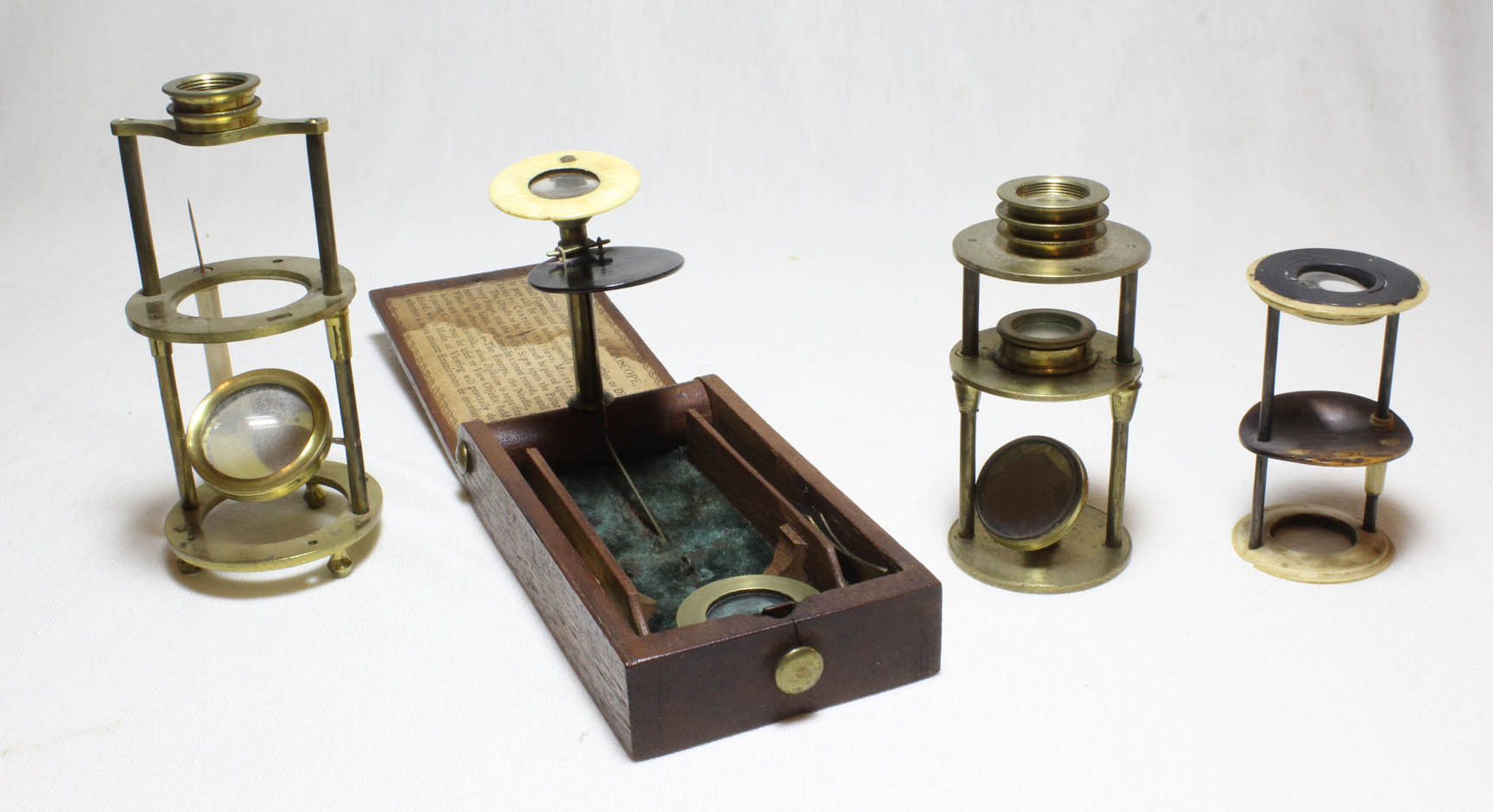
 This collection contains four examples of Withering-type microscopes; none are signed or numbered, as was usual.
One of the oldest, dating to about the year 1800, (and closest to the original depicted in the engraving near the bottom of this page below) is
constructed mainly of ivory
with a solid stage. Supported by two brass rods are lens casings at
each end. Only one of the two casings still has a lens.
The stage can be moved up or down to focus. This construction differs
from Withering's description in that the original instrument was
described as being entirely or mainly of brass and it notes that the
lenses could slide up or down to focus, apparently within their
supporting brass discs at each end. Furthermore, the original
instrument had three pillars, rather than the two as on all the
examples on this page.
This instrument is contained in a black leather covered cylindrical
case. There are holes in the stage which could
be used to store a tweezer and two additional instruments such as
dissecting needles or a scalpel. This instrument is virtually identical
to Bracegirdle's number 7/9 of the Science Museum (London).
This collection contains four examples of Withering-type microscopes; none are signed or numbered, as was usual.
One of the oldest, dating to about the year 1800, (and closest to the original depicted in the engraving near the bottom of this page below) is
constructed mainly of ivory
with a solid stage. Supported by two brass rods are lens casings at
each end. Only one of the two casings still has a lens.
The stage can be moved up or down to focus. This construction differs
from Withering's description in that the original instrument was
described as being entirely or mainly of brass and it notes that the
lenses could slide up or down to focus, apparently within their
supporting brass discs at each end. Furthermore, the original
instrument had three pillars, rather than the two as on all the
examples on this page.
This instrument is contained in a black leather covered cylindrical
case. There are holes in the stage which could
be used to store a tweezer and two additional instruments such as
dissecting needles or a scalpel. This instrument is virtually identical
to Bracegirdle's number 7/9 of the Science Museum (London).
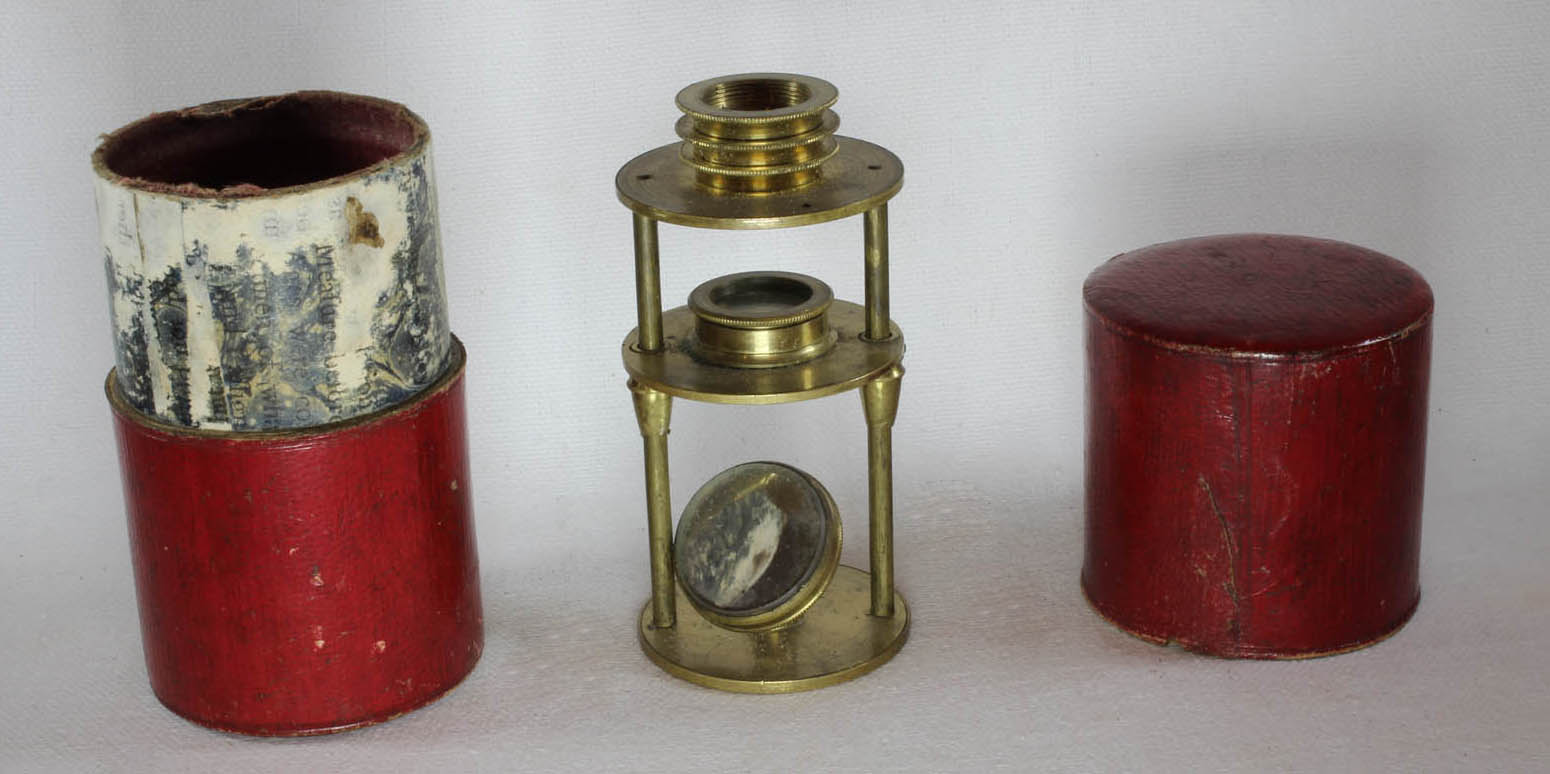 The
second instrument, dating to about 1805, is all brass, with stacking
lenses and a solid lower base with an attached tilting mirror on a very
small pillar arising from the center of the bottom disc. Its
cylindrical case is covered in red leather. Like the others depicted on
this page, it has two pillars rather than the three as the original.
This instrument is very similar if not identical to Bracegirdle's
number 7/2 in the Science Museum (London).
The
second instrument, dating to about 1805, is all brass, with stacking
lenses and a solid lower base with an attached tilting mirror on a very
small pillar arising from the center of the bottom disc. Its
cylindrical case is covered in red leather. Like the others depicted on
this page, it has two pillars rather than the three as the original.
This instrument is very similar if not identical to Bracegirdle's
number 7/2 in the Science Museum (London).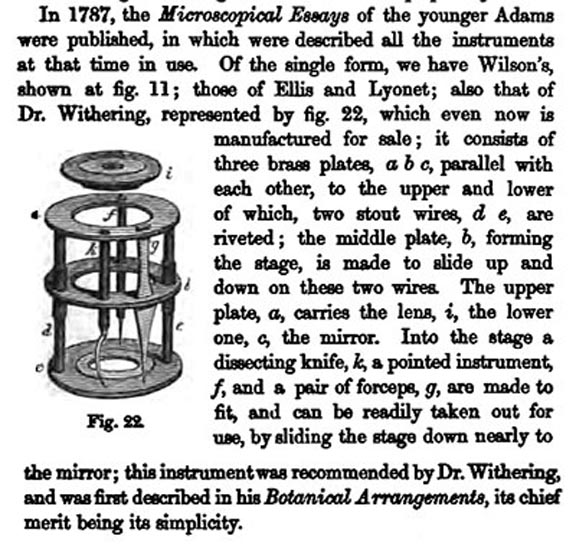
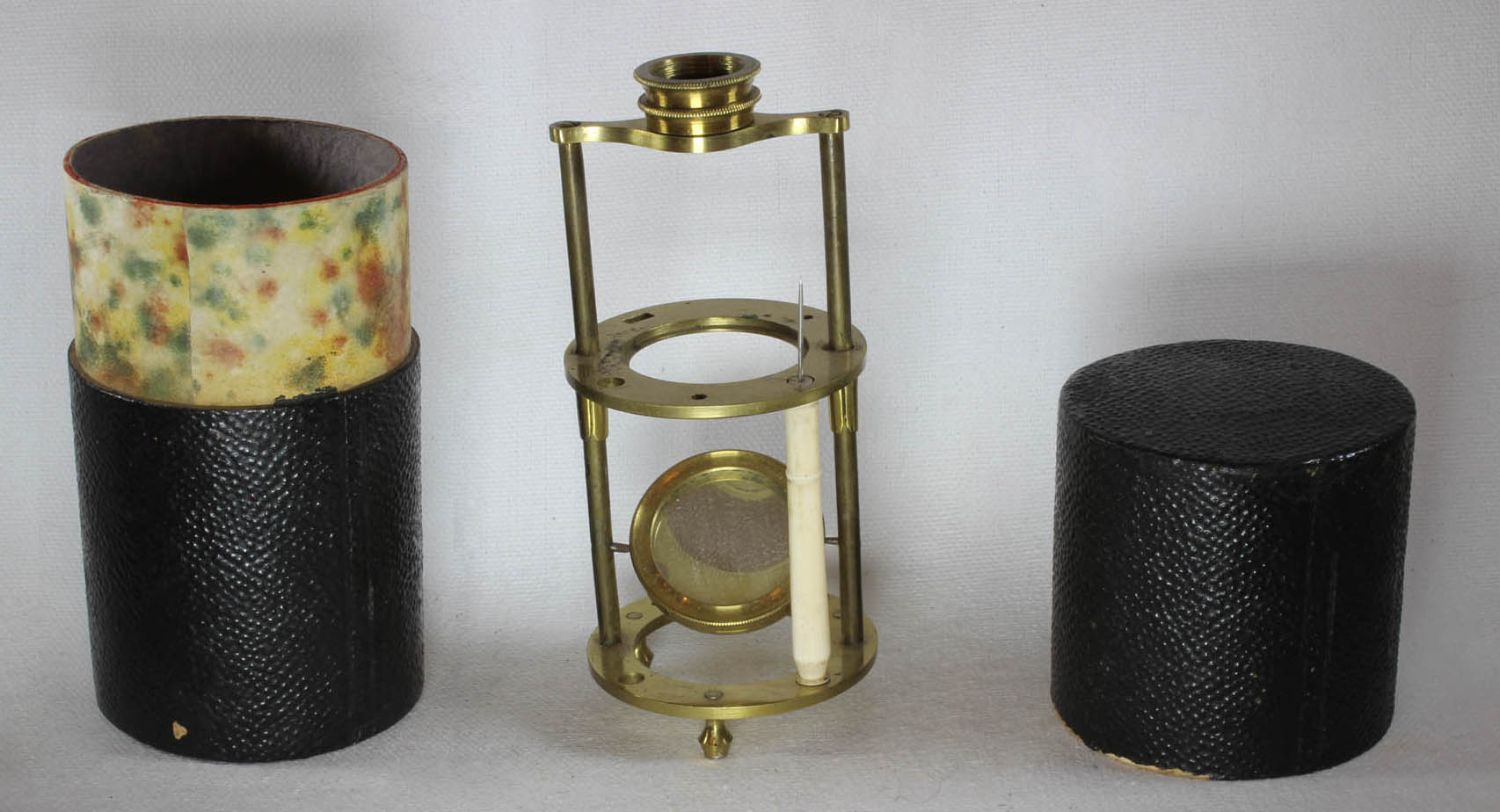 The third example, dating to about 1815, is close to, but not exactly
the pattern described by John Quekett
as being offered in 1787 by George Adams as described in the
illustration here. The main difference from that is the fact that the
top has a brass bar between the two supporting rods instead of a ring
as in Quekett's illustration. It also carries stacking lenses instead
of a single lens. Unlike the second example shown here above, here the
mirror is not attached to the bottom disc, which limits its range of tilting, but instead is supported
between the pillars allowing it to be tilted to any angle. You will
note that Quekett's illustration
shows the mirror flat at the bottom, the illumination assumed to be adjusted by tilting the entire instrument, or tilting the light source.
Curiously, this somewhat less than satisfactory method of illumination,
with the mirror fixed in position, was revived in some early twentieth
century instruments, notably the early version of the Tami microscope
by Hensholdt, also seen
on this site. This Withering microscope has a cylindrical fish-skin
covered case with black exterior. Again, unlike the original, but like
the others on this page, it has two pillars instead of three. This
instrument is identical to Bracegirdle's number 7/3 of the Science
Museum (London).
The third example, dating to about 1815, is close to, but not exactly
the pattern described by John Quekett
as being offered in 1787 by George Adams as described in the
illustration here. The main difference from that is the fact that the
top has a brass bar between the two supporting rods instead of a ring
as in Quekett's illustration. It also carries stacking lenses instead
of a single lens. Unlike the second example shown here above, here the
mirror is not attached to the bottom disc, which limits its range of tilting, but instead is supported
between the pillars allowing it to be tilted to any angle. You will
note that Quekett's illustration
shows the mirror flat at the bottom, the illumination assumed to be adjusted by tilting the entire instrument, or tilting the light source.
Curiously, this somewhat less than satisfactory method of illumination,
with the mirror fixed in position, was revived in some early twentieth
century instruments, notably the early version of the Tami microscope
by Hensholdt, also seen
on this site. This Withering microscope has a cylindrical fish-skin
covered case with black exterior. Again, unlike the original, but like
the others on this page, it has two pillars instead of three. This
instrument is identical to Bracegirdle's number 7/3 of the Science
Museum (London). 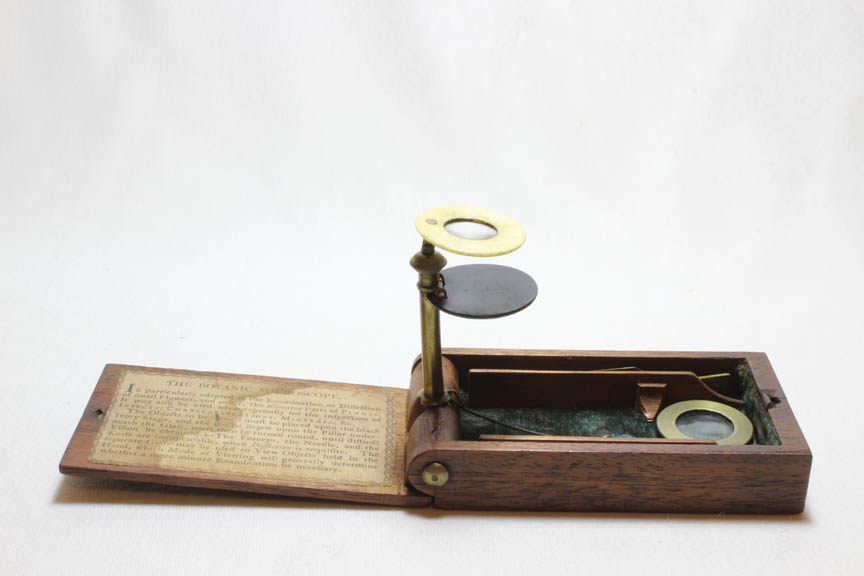 The fourth member of this group of instruments, added to this collection in July of 2017, is the famous form which self-erects when its wooden case is opened. The case is made of mahogony with a green baize lining on its bottom. When the top is opened, the pillar, (resting in a groove on a wooden cylinder glued to the lid), comes up as it comes in contact with the end of the groove, and is supported further by a wire attached to it and sliding along a thin groove in the bottom of the case. There is a metal rod of very small diameter hidden under the green lining which acts as a stop for the supporting wire once the microscope is upright. The instrument includes a solid ivory stage and three accessories stored in the box. The accessories include a dissecting needle, a scalpel, and a low power brass-enclosed hand lens. The lens of the microscope itself is of a slightly higher power. Other examples are known with brass housing for the hand lens, and some have a hand lens with an ivory housing.
The fourth member of this group of instruments, added to this collection in July of 2017, is the famous form which self-erects when its wooden case is opened. The case is made of mahogony with a green baize lining on its bottom. When the top is opened, the pillar, (resting in a groove on a wooden cylinder glued to the lid), comes up as it comes in contact with the end of the groove, and is supported further by a wire attached to it and sliding along a thin groove in the bottom of the case. There is a metal rod of very small diameter hidden under the green lining which acts as a stop for the supporting wire once the microscope is upright. The instrument includes a solid ivory stage and three accessories stored in the box. The accessories include a dissecting needle, a scalpel, and a low power brass-enclosed hand lens. The lens of the microscope itself is of a slightly higher power. Other examples are known with brass housing for the hand lens, and some have a hand lens with an ivory housing.
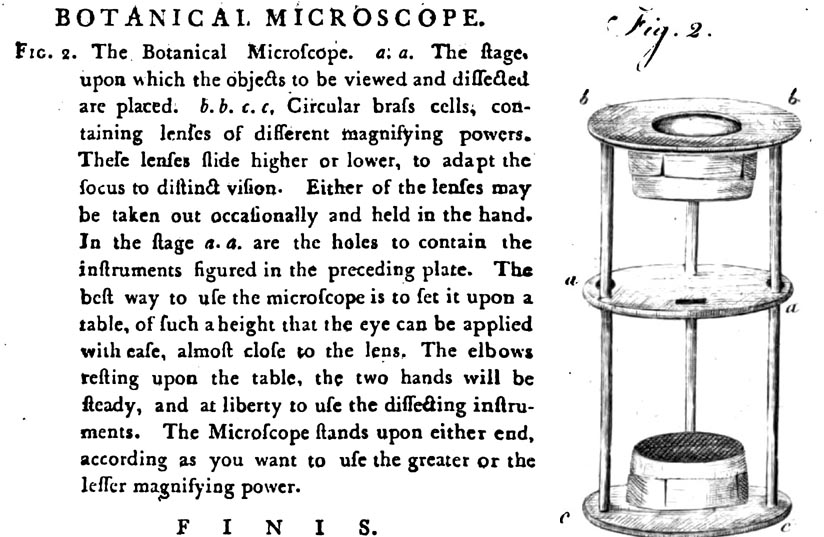 In: 'A Botanical Arrangement of all the VEGETABLES naturally growing in
Great-Britain, Vol II', published 1776, William Withering, MD described
his botanical microscope. The original figure depicts a microscope for
viewing only opaque objects and has three supports. There was a lens on
each end for different magnifications and a single slot in the stage to
accommodate a small tweezer. It most closely resembles the ivory
version in this collection, although the latter has only two supports
rather than three, and focus is by moving the stage, not the lens.
Later adaptations included the provision for a substage mirror (as seen
in the later two examples shown above) for viewing transparent or
translucent objects. Also introduced were stacking objectives, and more
slots for additional tools which could include a scalpel, dissecting
needle and stage forceps. The addition a small circular live-box was
also common.
In: 'A Botanical Arrangement of all the VEGETABLES naturally growing in
Great-Britain, Vol II', published 1776, William Withering, MD described
his botanical microscope. The original figure depicts a microscope for
viewing only opaque objects and has three supports. There was a lens on
each end for different magnifications and a single slot in the stage to
accommodate a small tweezer. It most closely resembles the ivory
version in this collection, although the latter has only two supports
rather than three, and focus is by moving the stage, not the lens.
Later adaptations included the provision for a substage mirror (as seen
in the later two examples shown above) for viewing transparent or
translucent objects. Also introduced were stacking objectives, and more
slots for additional tools which could include a scalpel, dissecting
needle and stage forceps. The addition a small circular live-box was
also common. 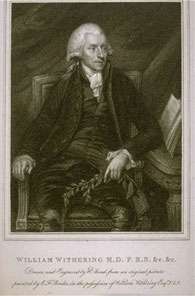 Dr Withering is famous in medical circles as the discoverer of Foxglove as a source of Digitalis,
an effective treatment for what was then called “dropsy” and now referred to as congestive heart failure. He started to study this in 1775 and published an amazingly thorough publication about how to safely use it in 1785. It is interesting to note that his first example of his botanical microscope was constructed at about the time he started to study digitalis, published in his treatise on British plants.
Digitalis was a standard treatment for this condition for centuries and is sometimes still used today especially to
control rapid heart rates in patients who have both congestive heart failure and atrial fibrillation.
Its narrow toxic-therapeutic ratio and the suggestion that it does not prolong lifespan (compared to other more modern
therapies), has led to its being avoided as first line therapy these days for patients with only congestive heart failure
without rapid atrial fibrillation. In Withering's time however, digitalis was the only effective "diuretic" agent, and surely led to symptomatic improvement of those with congestive heart failure.
Dr Withering is famous in medical circles as the discoverer of Foxglove as a source of Digitalis,
an effective treatment for what was then called “dropsy” and now referred to as congestive heart failure. He started to study this in 1775 and published an amazingly thorough publication about how to safely use it in 1785. It is interesting to note that his first example of his botanical microscope was constructed at about the time he started to study digitalis, published in his treatise on British plants.
Digitalis was a standard treatment for this condition for centuries and is sometimes still used today especially to
control rapid heart rates in patients who have both congestive heart failure and atrial fibrillation.
Its narrow toxic-therapeutic ratio and the suggestion that it does not prolong lifespan (compared to other more modern
therapies), has led to its being avoided as first line therapy these days for patients with only congestive heart failure
without rapid atrial fibrillation. In Withering's time however, digitalis was the only effective "diuretic" agent, and surely led to symptomatic improvement of those with congestive heart failure.